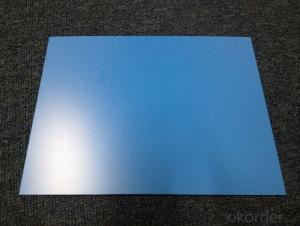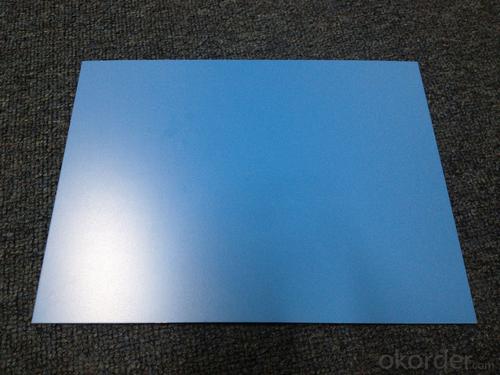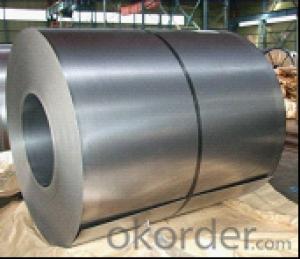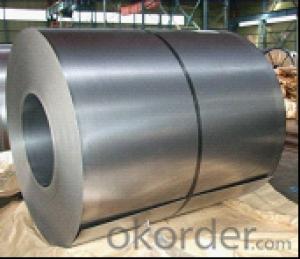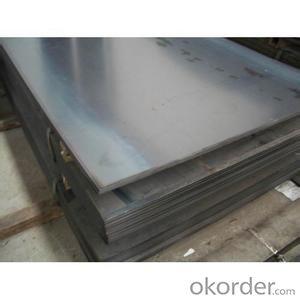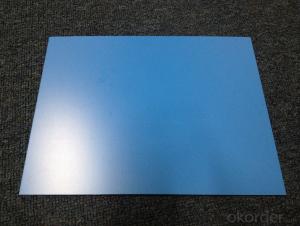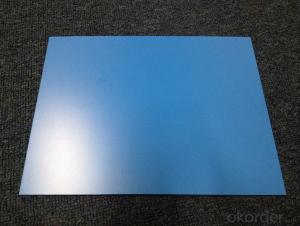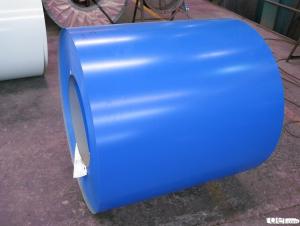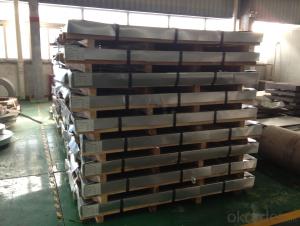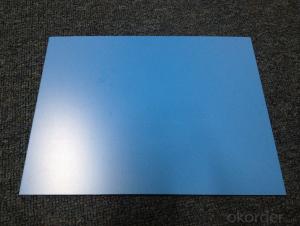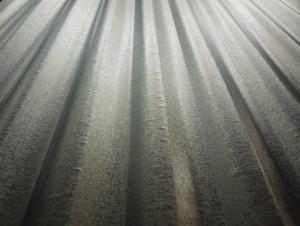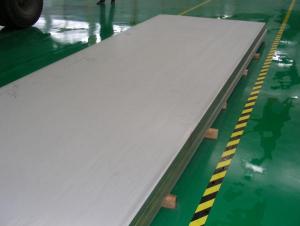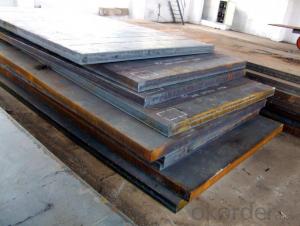HS PRE-PAINTED ALUZINC STEEL SHEET
- Loading Port:
- Tianjin
- Payment Terms:
- TT OR LC
- Min Order Qty:
- -
- Supply Capability:
- 12000 m.t./month
OKorder Service Pledge
OKorder Financial Service
You Might Also Like
HS PRE-PAINTED ALUZINC STEEL SHEET
THICKNESS:0.18mm-1.5mm
WIDTH:900mm-1250mm
COATING MASS:AZ30-AZ180
PAINT:PE、HP、HDP、PVDF、SMP、MATT、PVDF
COLOR:RAL Scale
COIL INNER DIAMETER:508mm/610mm
COIL WEIGHT:3mt-7mt
BASE MATERIAL:Hot-dip Aluzinc Steel
Cold rolled plate of color coating steel plate
From the color plate cold rolling board production, has smooth and beautifulappearance, processing performance and has cold rolling board; but any tinyscratch the surface coating will put cold-rolled base plate is exposed in the air,so that the exposed iron quickly generated red rust. Therefore, this kind ofproduct can only be used for less demanding the temporary isolationmeasures and indoor materials.
Hot dip galvanized color coating steel plate
The organic paint coating on hot dip galvanized steel sheet on products for hotgalvanizing and coating plate. Hot dip galvanized Caitu besides the protective effect with zinc, organic coating on the surface also played isolation protection,prevent rust role, the service life is longer than the heat galvanized plate. The zinc content of hot dip galvanized substrate for general 180g/m2 (double),building external hot galvanized substrate galvanized weight up to 275g/m2.
Hot-dip zinc coated board
According to the requirement, also can use hot aluminium zinc plate as coating substrates (55%AI-Zn and 5%AI-Zn).
Electro galvanized and color coated sheet
Electricity galvanized plate as a substrate, coated with organic coating bakingincome products for electric galvanized Caitu, because the electric galvanized plate the zinc layer is thin, often containing zinc quantity is 20/20g/m2, theproduct is not suitable for production use in outdoor walls, roof. But because of its beautiful appearance and excellent processing performance, so it can be mainly used in household appliances, audio equipment, steel furniture, interior decoration, etc..
- Q: What is the average lifespan of a painted steel sheet?
- The lifespan of a painted steel sheet can differ based on several factors, including the paint quality, exposure to the environment, and maintenance. However, a well-maintained painted steel sheet typically lasts between 20 to 50 years. It should be emphasized that regular inspections, cleaning, and touch-up painting contribute to extending the sheet's lifespan. Furthermore, the durability of both the paint and the sheet can be greatly affected by exposure to severe weather, extreme temperatures, or corrosive environments.
- Q: What is the difference between a smooth and textured steel sheet?
- A smooth steel sheet and a textured steel sheet differ primarily in their surface appearance and feel. A smooth steel sheet has a flat and unblemished surface, with no visible patterns or textures. It provides a sleek and polished look, making it suitable for applications where aesthetics are important, such as architectural designs, interior decoration, or automotive body parts. On the other hand, a textured steel sheet has a surface that is intentionally manipulated to create patterns or textures. These patterns can range from simple lines or ridges to more intricate designs like diamond or checker plate patterns. The textured surface adds visual interest and can also enhance the sheet's functionality by providing improved grip or traction. The choice between a smooth and textured steel sheet depends on the intended use and desired outcome. Smooth steel sheets are often used in applications where a clean and polished look is desired, such as in high-end appliances or furniture. They are also commonly used in industries where a smooth surface is crucial for efficient processes, like food processing or packaging. Textured steel sheets, on the other hand, are preferred in applications where both functionality and aesthetics are important. For example, they are commonly used in flooring or stairs, as the textured surface provides additional grip and reduces the risk of slipping. These sheets are also found in truck beds, ramps, or walkways where enhanced traction is necessary. In summary, the primary difference between a smooth and textured steel sheet lies in their surface appearance and functionality. Smooth steel sheets provide a sleek and unblemished look, while textured steel sheets feature intentional patterns or textures that can enhance grip, traction, and visual interest. The choice between the two depends on the specific application requirements and desired outcome.
- Q: What is the process of galvalume coating on steel sheets?
- The process of galvalume coating on steel sheets involves a continuous hot-dip process. First, the steel sheets are cleaned and then immersed in a bath of molten zinc-aluminum alloy, which typically consists of 55% aluminum, 43.5% zinc, and 1.5% silicon. The steel sheets are carefully passed through the molten bath, ensuring that both sides are evenly coated. As the sheets are withdrawn from the bath, excess alloy is removed by air knives, leaving a thin layer of the galvalume coating on the steel surface. This coating provides excellent corrosion resistance and durability to the steel sheets.
- Q: What is the typical weight of steel sheets?
- The typical weight of steel sheets varies depending on their size, thickness, and type of steel being used. Generally, steel sheets can range in weight from a few pounds to several tons. For example, a standard 4x8 foot steel sheet with a thickness of 1/4 inch can weigh around 110 pounds, while a larger 10x10 foot sheet with a thickness of 1 inch can weigh over 1,000 pounds. It is important to note that these are just general estimates, and the weight can vary based on specific factors such as the alloy composition or any additional coatings applied to the steel sheets.
- Q: Can steel sheets be used for garage doors?
- Yes, steel sheets can be used for garage doors. Steel is a durable and strong material that provides security and protection for garage doors. It is commonly used due to its resistance to weather elements and its ability to withstand impact. Steel sheets are also available in various thicknesses and designs, offering flexibility in aesthetics and functionality for garage doors.
- Q: What are the different coating options for steel sheets (powder coating, paint, etc.)?
- There are several different coating options available for steel sheets, each offering unique benefits and characteristics. Some of the most common coating options include: 1. Powder coating: Powder coating involves applying a dry powder coating material onto the steel sheet. This coating is then cured under heat to form a protective layer. Powder coating provides excellent durability, corrosion resistance, and aesthetic appeal. It is also environmentally friendly, as it does not contain solvents or VOCs. 2. Paint: Paint is one of the most traditional coating options for steel sheets. It involves applying liquid paint onto the surface, which then dries and forms a protective layer. Paint coatings offer a wide range of colors and finishes, making them suitable for various applications. However, they may require periodic maintenance and can be susceptible to chipping and peeling. 3. Galvanizing: Galvanizing is a popular coating method for steel sheets, especially in industries where corrosion resistance is crucial. It involves applying a layer of zinc onto the steel surface through a hot-dip process. This creates a protective barrier that prevents corrosion and rusting. Galvanized coatings are highly durable and long-lasting. 4. Epoxy coatings: Epoxy coatings are known for their excellent chemical resistance and adhesion properties. They provide a tough and durable finish that protects steel sheets from corrosion, chemicals, and abrasion. Epoxy coatings are commonly used in industrial settings where harsh conditions are prevalent. 5. Chromate conversion coatings: Chromate conversion coatings, also known as chemical conversion coatings, are applied to steel sheets to enhance their corrosion resistance and improve paint adhesion. These coatings are typically thin and translucent, providing a clear or slightly yellowish appearance. Chromate conversion coatings are commonly used as a pre-treatment before painting or powder coating. 6. Ceramic coatings: Ceramic coatings offer exceptional heat resistance and durability. They are often utilized in high-temperature applications, such as exhaust systems or industrial ovens. Ceramic coatings can withstand extreme temperatures, corrosion, and abrasion, making them ideal for demanding environments. These are just a few of the coating options available for steel sheets. The choice of coating will depend on factors such as the intended application, desired appearance, environmental conditions, and budget. Consulting with a coating specialist or manufacturer can help determine the most suitable coating option for specific requirements.
- Q: How do steel sheets handle weathering?
- Steel sheets are designed to handle weathering quite effectively. They are typically coated with a protective layer, such as zinc or a combination of zinc and aluminum, which creates a barrier against moisture and other environmental elements. This coating, known as galvanization, prevents the steel from corroding or rusting when exposed to rain, snow, and other forms of precipitation. In addition to the protective coating, steel sheets are also treated with various chemical processes to enhance their resistance to weathering. These processes may include the application of primers, paints, or sealants that further shield the steel from moisture, UV radiation, and extreme temperature fluctuations. Moreover, the composition of steel itself contributes to its ability to withstand weathering. Steel is an alloy comprised primarily of iron, carbon, and other elements, which gives it inherent strength and durability. This structural integrity allows steel sheets to resist deformation, cracking, or warping that may occur due to weather-related stresses. However, it is important to note that over time, even the most well-protected steel sheets may experience some degree of weathering. Exposure to harsh environmental conditions can gradually degrade the protective coating, leading to the formation of small areas of rust or corrosion. Regular maintenance, such as cleaning, inspecting, and reapplying protective coatings, can help prolong the lifespan of steel sheets and maintain their resistance to weathering.
- Q: Are steel sheets suitable for high-humidity environments?
- Yes, steel sheets are generally suitable for high-humidity environments. Steel is a corrosion-resistant material, and when properly coated or treated, it can withstand prolonged exposure to moisture without significant degradation. However, it is important to ensure proper maintenance and periodic inspections to prevent any potential rust or corrosion.
- Q: What are the disadvantages of using steel sheets?
- Some potential disadvantages of using steel sheets are their susceptibility to corrosion, their relatively high cost compared to other materials, and their heavy weight, which can make installation and transportation more challenging. Additionally, steel sheets may require regular maintenance to prevent rust and may not be suitable for certain design aesthetics or applications where a lighter material is desired.
- Q: Is galvanized steel plate fire-resistant?
- Should be refractory, but the melting point of zinc relative to steel is relatively low, 420 degrees or so, if higher than this temperature, galvanized layer will be destroyed, the bottom plate is no problem.
Send your message to us
HS PRE-PAINTED ALUZINC STEEL SHEET
- Loading Port:
- Tianjin
- Payment Terms:
- TT OR LC
- Min Order Qty:
- -
- Supply Capability:
- 12000 m.t./month
OKorder Service Pledge
OKorder Financial Service
Similar products
Hot products
Hot Searches
Related keywords
